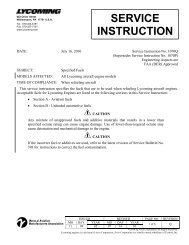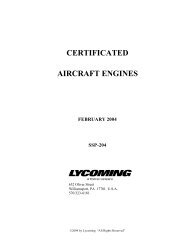Create successful ePaper yourself
Turn your PDF publications into a flip-book with our unique Google optimized e-Paper software.
used, either or both instruments are useful indicators. When<br />
the airplane uses a constant speed propeller, the airspeed<br />
indicator is useful. Regardless of the propeller type, set<br />
the controls for the desired cruise power as shown in the<br />
Pilot’s Operating Handbook. Gradually lean the mixture from<br />
full rich until either the tachometer or the airspeed indicator<br />
are reading peaks. At peak indication the engine is operating<br />
in the maximum power range.<br />
b. For Cruise Power: Where best economy operation is allowed<br />
by the manufacturer, the mixture is first leaned from full rich<br />
to maximum power, then leaning is slowly continued until<br />
engine operation becomes rough or until engine power is<br />
rapidly diminishing as noted by an undesirable decrease in<br />
airspeed. When either condition occurs, enrich the mixture<br />
sufficiently to obtain an evenly firing engine or to regain<br />
most of the lost airspeed or engine RPM. Some slight engine<br />
power and airspeed must be sacrificed to gain a best economy<br />
mixture setting.<br />
c. Exhaust Gas Temperature Method (EGT): Refer to the<br />
article on this subject in the Operations section of this book.<br />
Recommended fuel management — manual leaning will not only<br />
result in less engine deposits and reduced maintenance cost, but<br />
will provide more economical operation and fuel savings.<br />
B. ENGINE GROUND OPERATION<br />
The engine ground operation greatly influences formation of<br />
lead salt deposits on spark plugs and exhaust valve stems. Proper<br />
operation of the engine on the ground (warm-up, landing, taxi<br />
and engine shut-down) can greatly reduce the deposition rate and<br />
deposit formation which cause spark plug fouling and exhaust<br />
valve sticking.<br />
1. Proper adjustment of the idle speed (600 to 650 RPM) fuel<br />
mixture, and maintenance of the induction air system will ensure<br />
smooth engine operation and eliminate excessively rich fuel/air<br />
mixtures at idle speeds. This will minimize the separation of the<br />
nonvolatile components of the high-leaded aviation fuels greatly<br />
retarding the deposition rate.<br />
2. The engine should be operated at engine speeds between<br />
1000 and 1200 RPM after starting and during the initial warmup<br />
period. Avoid prolonged closed-throttle idle engine speed<br />
operation (when possible). At engine speeds from 1000 to 1200<br />
RPM, the spark plug core temperatures are hot enough to activate<br />
the lead scavenging agents contained in the fuel which retards<br />
the formation of the lead salt deposits on the spark plugs and<br />
exhaust valve stems. Avoid rapid engine speed changes after startup,<br />
and use only the power settings required to taxi.<br />
3. Rapid engine cooldown from low-power altitude changes, lowpower<br />
landing approach and/or engine shut-down too soon after<br />
landing or ground runs should be avoided.<br />
4. Prior to the engine shut-down, the engine speed should be<br />
maintained between 1000 and 1200 RPM until the operating<br />
temperatures have stabilized. At this time, the engine speed<br />
should be increased to approximately 1800 RPM for 15 to 20<br />
seconds, then reduced to 1000 to 1200 RPM and shut down<br />
immediately using the mixture control.<br />
L y c o m i n g F l y e r<br />
C. LUBRICATION RECOMMENDATIONS<br />
Many of the engine deposits formed by combustion, regardless of<br />
the lead content of fuel used, are in suspension within the engine<br />
oil and are not removed by a full-flow filter. When sufficient<br />
amounts of these contaminants in the oil reach high temperature<br />
areas of the engine, they can be baked out, resulting in possible<br />
malfunctions such as in exhaust valve guides, causing sticking<br />
valves. The recommended periods of 50-hour interval oil change<br />
and filter replacement for all engines using full-flow filtration<br />
system and 25-hour intervals for oil change and screen cleaning<br />
for pressure screen systems must be followed. If valve sticking is<br />
noted, all guides should be reamed using the procedures stated<br />
in latest editions of Service Instruction No. 1116 and/or Service<br />
Instruction No. 1425, and the time between oil and filter changes<br />
should be reduced.<br />
D. SPARK PLUGS<br />
The fuel management techniques outlined previously will aid<br />
in minimizing spark plug fouling. Engine operation, spark plug<br />
selection and spark plug maintenance are all factors that help to<br />
keep engines operating smoothly with leaded fuels.<br />
If the magneto check before or after flight reveals any roughness<br />
caused by a fouled spark plug, open the throttle slowly and<br />
smoothly to cruise RPM, and lean the mixture as far as possible<br />
(yet with a smooth engine). After several seconds leaned, return<br />
to the proper mixture position for takeoff and recheck the magneto.<br />
If two such attempts do not clear the fouled plug, then return<br />
to the line and report the problem to maintenance.<br />
Spark plugs should be rotated from top to bottom on a 50-hour<br />
basis, and serviced on a 100-hour basis. If excessive spark plug<br />
lead fouling occurs, the selection of a hotter plug from the<br />
approved list in Service Instruction No. 1042 may be necessary.<br />
However, depending on the type of lead deposit formed, a colder<br />
plug from the approved list may better resolve the problem.<br />
Depending on the lead content of the fuel and the type of operation,<br />
more frequent cleaning of the spark plugs may be necessary.<br />
Where the majority of operation is at low power, such as<br />
patrol, a hotter plug would be advantageous. If the majority of<br />
operation is at high cruise power, a colder plug is recommended.<br />
Spark plug fouling is not limited to engines that were certified<br />
for 80-octane aviation fuel, but which are using the higher leaded<br />
100-octane gasoline. Therefore, the techniques recommended<br />
herein for operation and maintenance apply to all <strong>Lycoming</strong><br />
piston engines, but with emphasis on the 80-octane engine<br />
using 100-octane fuel.<br />
E. SUMMARY<br />
When Grade 80 aviation gasoline was first phased out, the<br />
highly leaded Grade 100 green fuel was the only alternative<br />
for some operators. During that period of time, in the middle<br />
1970s, exhaust valve erosion was a concern for the operators of<br />
low-compression engines. There are two reasons why this should<br />
not cause concern today. First, Grade 100LL does not cause this<br />
problem, and second, the materials used in <strong>Lycoming</strong> exhaust<br />
valves are highly resistant to erosion.







